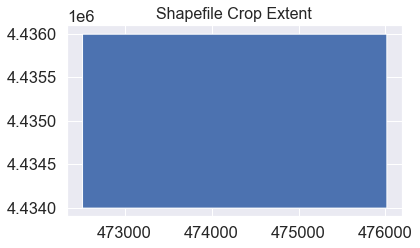

P <- shapefile(system.file("external/lux. # crop a SpatialPolygon* object with another one Values within the extent of a Raster* object can be set to NA with mask See AlsoĮxtend, merge Examples r <- raster(nrow=45, ncol=90)ī <- as(extent(6, 6.4, 49.75, 50), 'SpatialPolygons') RasterLayer or RasterBrick object or SpatialLines or SpatialPolygons object. To crop by row and column numbers you can create an extent like this (for Raster x, row 5 to 10, column 7 to 12) New Extent objects can also be created with function extent and drawExtent by clicking twice on a plot. First, the raster gets cropped to the rectangular extent of the data file used for the clipping (crop function), and then all the cells that have no values in the data file WITHIN the square extent that is used for the clipping are set to NoData (mask function). You can check this with the extent function. For example, clipping a raster is a two step process. I would like to clip out just the two northeastern provinces (Ituri and North-Kivu in R and save the clipped file as a. Objects from which an Extent can be extracted/created include RasterLayer, RasterStack, RasterBrick and objects of the Spatial* classes from the sp package. This single-band raster file has about 5.17 million grids cells each at the 30-arc second resolution for the entire country. Output dataType (by default it is the same as the input datatype) One of 'near', 'in', or 'out', for use with alignExtentĬharacter. The raster is cropped with no errors but when I try and plot the cropped raster I get the following Stack Exchange Network Stack Exchange network consists of 183 Q&A communities including Stack Overflow, the largest, most trusted online community for developers to learn, share their knowledge, and build their careers. Raster* object or SpatialPolygons*, SpatialLines*, or SpatialPoints* objectĮxtent object, or any object from which an Extent object can be extracted (see Details)Ĭharacter. We crop the raster with the polygon using the crop function from the raster package: 1. Usage # S4 method for signature 'Raster'Ĭrop(x, y, filename="", snap='near', datatype=NULL.

About Products For Teams Stack Overflow Public questions & answers Stack. This means changing projection, cellsize (the template raster has a bigger cellsize) extent and NA cells so that each non-NA cell on the template raster has matching cell on the bioclimatic rasters. Areas included in y but outside the extent of x are ignored (see extend if you want a larger area). library(raster) rastercrop <-crop('mypath', Stack Overflow. I have a set of bioclimatic rasters that I'd like to crop and change to match my template raster. If x is a Raster* object, the Extent is aligned to x. library(raster)Įxtent_1 = c(756472.2 ,4074670 ,757322.Crop returns a geographic subset of an object as specified by an Extent object (or object from which an extent object can be extracted/created). This SpatRaster has forest age for desired forests in this area of interest - the rest is a lot of NAs. I also need to use resample and add the precipitation data as a new layer to a SpatRaster. How can I solve this problem, when the purpose of stacking them together to compute standard deviation? I also tried using the raster::extend function but that is giving me a memory error. Id like to obtain total annual precipitation for one desired area for these 34 years. But, when I use the crop function to crop one raster on the basis of the other raster's extent, their extents still don't match up i.e., xmax of rast1 doesn't change from 757322.8 to 757322.7. So, I have two different rasters, and I am trying to match their extent, even though the difference in their existing extents is quite small, but still raster::stack won't stack which is understandable. envs raster::crop(chelsaenvs, mcp) but I'm getting 'no non-missing arguments to min (and max) returning inf' errors.


 0 kommentar(er)
0 kommentar(er)
